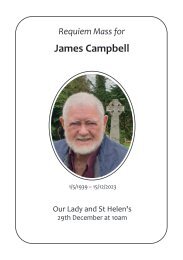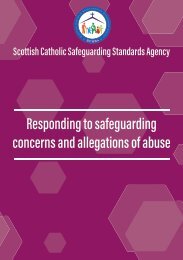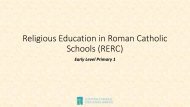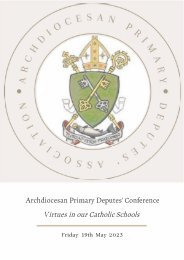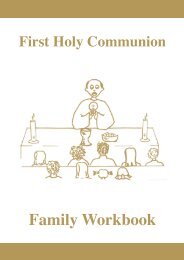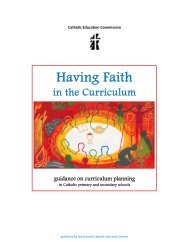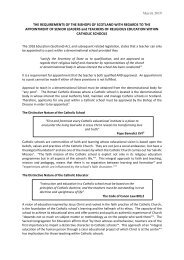Chaplaincy Report Secondary schools
Create successful ePaper yourself
Turn your PDF publications into a flip-book with our unique Google optimized e-Paper software.
<strong>Chaplaincy</strong> in Catholic<br />
<strong>Secondary</strong> Schools<br />
in Scotland<br />
a report of the<br />
Catholic Education Commission - Scotland
TABLE OF CONTENTS<br />
SECTIONS<br />
page<br />
1 Introduction ...............................................................................................................................................................2<br />
2 Summary of recommendations...................................................................................................................................3<br />
3 The role of the school Chaplain in a secondary school ................................................................................................4<br />
4 <strong>Chaplaincy</strong> as a whole-school responsibility................................................................................................................9<br />
5 Planning a pastoral and liturgical calendar................................................................................................................11<br />
6 Training for Chaplains and <strong>Chaplaincy</strong> Teams ...........................................................................................................12<br />
7 Support for all pupils ................................................................................................................................................14<br />
APPENDICES<br />
1 List of Liturgical & Pastoral Events for inclusion in school calendar ............................................................................16<br />
2 Bibliography.............................................................................................................................................................17<br />
3 A Diocesan Handbook for <strong>Secondary</strong> School Chaplains.............................................................................................18<br />
4 A Charter for Catholic Schools ..................................................................................................................................19<br />
ACKNOWLEDGEMENT<br />
The working group acknowledges with thanks the support of Catholic secondary <strong>schools</strong> in the preparation of this report.<br />
In particular, we are grateful to colleagues in those <strong>schools</strong> which supplied copies of their own school papers, many of<br />
which have helped to shape the contents of this report.<br />
© Scottish Catholic Education Service<br />
Published by the Scottish Catholic Education Service on behalf of the Catholic Education Commission<br />
January 2009<br />
This text may be freely reproduced in whole or in part for non-commercial education purposes, provided that any<br />
extracts quoted are reproduced verbatim without adaptation, and on condition that the source and date are noted.<br />
<strong>Chaplaincy</strong> in Catholic <strong>Secondary</strong> Schools in Scotland<br />
1
1 Introduction<br />
This report has been produced by a working group established by the Catholic Education Commission for Scotland.<br />
1.1 GROUP MEMBERSHIP<br />
Anthony Finn, (Chair) formerly Senior Manager, Fife Council; now Chief Executive, GTC Scotland<br />
William Liston, RE Adviser, Diocese of Motherwell<br />
Very Rev. Kenneth McCaffrey, Vicar-General, Diocese of Dunkeld<br />
John McGachey, DHT, Cardinal Newman High School<br />
Michael McGrath, Director, Scottish Catholic Education Service<br />
Martin McMahon, PT Religious Education, Taylor High School<br />
Anne Marie Rough, PT Pupil Support, St Columba’s High School, Dunfermline<br />
John Russell, Lay Chaplain, St Andrew’s and St Bride’s High School, East Kilbride<br />
1.2 REMIT AND RATIONALE<br />
The group was given the following remit:<br />
i. developing guidelines for Dioceses on supporting <strong>Chaplaincy</strong> services in secondary <strong>schools</strong><br />
ii. developing guidelines for secondary <strong>schools</strong> on the provision of <strong>Chaplaincy</strong> services<br />
iii. developing resources for secondary <strong>schools</strong> for prayer and liturgical celebration<br />
iv. developing CPD provision for secondary school <strong>Chaplaincy</strong> Teams<br />
v. keeping a watching brief on LTS support for Religious Observance.<br />
The group agreed to concentrate initially on items i and ii of this remit and to use its responsibility for the remaining three<br />
items to inform the contents of the report.<br />
1.3 MODUS OPERANDI<br />
The group met regularly to consider the principles which could be recommended to <strong>schools</strong> and dioceses. In particular,<br />
the group:<br />
a. carried out a survey of <strong>Chaplaincy</strong> practice and support across all Catholic secondary <strong>schools</strong> in Scotland<br />
b. considered good practice from the survey and from the experience of members of the group<br />
c. identified principles which were important to the support of <strong>Chaplaincy</strong><br />
d. considered documents which had been produced by <strong>schools</strong> or dioceses in the past or recent past<br />
e. recognised the significance of the Charter for Catholic Schools in the development of an appropriate ethos for<br />
<strong>Chaplaincy</strong> in Catholic <strong>schools</strong><br />
f. took account of issues which they considered to be relevant to this report including:<br />
i current levels of recruitment to the priesthood and the implications of these for the support which the Church can<br />
offer to <strong>schools</strong><br />
ii workload issues for teachers<br />
iii the changing population of Catholic <strong>schools</strong> in the early 21st century<br />
iv patterns of practice of the Catholic faith<br />
v <strong>Chaplaincy</strong> as a whole-school responsibility<br />
vi how to ensure that the support needs of Chaplains and <strong>Chaplaincy</strong> Teams are met.<br />
2<br />
<strong>Chaplaincy</strong> in Catholic <strong>Secondary</strong> Schools in Scotland
Summary of<br />
Recommendations<br />
2<br />
Recommendation 1:<br />
Recommendation 2:<br />
Recommendation 3:<br />
Recommendation 4:<br />
Recommendation 5:<br />
Recommendation 6:<br />
Recommendation 7:<br />
Recommendation 8:<br />
Recommendation 9:<br />
Schools should be able to benefit from the support of a priest wherever possible. To achieve this<br />
aim, Dioceses are advised to nominate a priest to work in liaison with specified <strong>schools</strong> in their<br />
area. (Page 4)<br />
Each school should establish a <strong>Chaplaincy</strong> Team which will work with the Chaplain(s) and other<br />
staff to promote the religious and pastoral life of the school community. (Page 5)<br />
Within each deanery there should be regular opportunities to consider how <strong>schools</strong> and parishes<br />
can support each other in their work in the community. (Page 5)<br />
The <strong>Chaplaincy</strong> Team has a responsibility to offer support which is relevant to the school, its staff<br />
and its pupils in its given context, which may vary significantly from school to school. (page 7)<br />
Each school should use Sections 3.5 to 3.9 of this report as guidelines for the work of the School<br />
Chaplain and <strong>Chaplaincy</strong> Team. (page 7)<br />
Each school, in partnership with the local deanery, should use these guidelines to agree a plan<br />
which will allow the <strong>Chaplaincy</strong> Team to have access to the resources and support which it needs.<br />
(page 8)<br />
Each school should, through the SMT link, work closely with the <strong>Chaplaincy</strong> Team to ensure that<br />
there is a shared understanding of the responsibilities of the school in areas such as Child<br />
Protection and legal accountability to parents and others. (page 8)<br />
Every member of the school community should share in the benefits of the school’s ethos and<br />
should consider carefully how to contribute to its promotion and development. (page 9)<br />
Schools should give consideration to the advice offered in Section 4.5 of this report in planning<br />
the role of the Chaplain in supporting Religious Education across the school. (page 10)<br />
Recommendation 10: Dioceses should consider the value of providing a Diocesan Handbook on School <strong>Chaplaincy</strong>.<br />
(page 10)<br />
Recommendation 11: Each school should devise an annual calendar which takes account of all known pastoral and<br />
liturgical events and should incorporate this calendar within the school’s annual planning process.<br />
(page 11)<br />
Recommendation 12: A coherent programme of training suitable to the needs of Chaplains and <strong>Chaplaincy</strong> Teams<br />
should be provided. This should include pre-service training, in service support and specific<br />
training to meet known needs as <strong>Chaplaincy</strong> programmes develop. (page 12)<br />
Recommendation 13: A national programme of training and development for seminarians and for priest Chaplains<br />
should be built up, with a view to ensuring consistency and coherence in the preparation of<br />
priests for School <strong>Chaplaincy</strong>. Similar provision should be available for lay and associate Chaplains<br />
working in <strong>schools</strong>. This programme should be supplemented regularly by training for Chaplains<br />
in each diocese and by the provision of national training events for Chaplains. (page 13)<br />
Recommendation 14: Schools should consider how best they might support the training of Chaplains and <strong>Chaplaincy</strong><br />
Teams. A member of the school Senior Management Team should be responsible for the<br />
oversight of this area and for ensuring that <strong>Chaplaincy</strong> Team members are aware of the<br />
opportunities open to them. The school should also allocate time for the promotion of <strong>Chaplaincy</strong><br />
as part of its annual school programme. (page 13)<br />
Recommendation 15: The <strong>Chaplaincy</strong> Team should extend an invitation to all pupils to contribute to and benefit from<br />
the ethos and community life of the school. (page 14)<br />
<strong>Chaplaincy</strong> in Catholic <strong>Secondary</strong> Schools in Scotland<br />
3
3<br />
The role of the school<br />
Chaplain in a secondary school<br />
3.1 PREAMBLE<br />
Every Catholic school seeks to promote the religious, spiritual, and moral education of young people. Schools are<br />
supported in emphasising this aim by the expectations which they share with parents and clergy.<br />
Together, <strong>schools</strong>, parents and parishes have the responsibility of giving all members of the school community an<br />
experience of Christian living – in relationships, in care for the individual and, above all, in the shared expression of faith.<br />
In addition, <strong>schools</strong> are required to provide for all members of their community the opportunity to grow in knowledge<br />
and love of Jesus and in understanding of the teachings of the Church.<br />
The School Chaplain has a central role in nourishing this community of faith.<br />
3.2 FORMS OF SCHOOL CHAPLAINCY<br />
3.2.1 PRIEST CHAPLAINS:<br />
Traditionally, the Chaplain is present in most Catholic <strong>schools</strong> because he is a priest. It is in the context of his ministerial<br />
priesthood that all his work – pastoral, spiritual, sacramental and liturgical – must be seen. His ministry is essentially one of<br />
service to everyone in the school and to other individuals and communities which the school serves. This he does by<br />
servicing the various needs of the individual and of the group, by being an evangelist and an example of the Christian<br />
way of life, by encouraging us to Christian prayer and action, by advising individuals on matters of faith and Christian<br />
living, and by acting as a bridge between school and home, and between school and parish.<br />
Recommendation 1:<br />
Schools should be able to benefit from the support of a priest wherever possible. To achieve<br />
this aim, Dioceses are advised to nominate a priest to work in liaison with specified <strong>schools</strong><br />
in their area.<br />
3.2.2. RELIGIOUS OR LAY CHAPLAINS:<br />
In a few <strong>schools</strong>, the Chaplain is a non-ordained member of a religious order or a lay person. As the number of Permanent<br />
Deacons increases, they may also begin to undertake or contribute to <strong>Chaplaincy</strong> work.<br />
Many aspects of the work of the Chaplain in these cases are similar to that of a priest Chaplain (with the obvious<br />
difference that a priest is able to undertake sacramental responsibilities and provide a specific vocational focus). However,<br />
these Chaplains also bring with them their own vocational experience, including life-experience and skills which<br />
complement the priestly vocation and offer a different dimension to the school. This can be of value to them in coordinating<br />
the work of the priests who support the school.<br />
Good Chaplains bring many individual qualities and strengths to a school community. They set a strong example of faith<br />
to pupils and staff; they are tolerant, compassionate and resilient; they are able to listen with sympathy and to offer<br />
constructive advice; they have good organisational skills; they can engage easily with young people and understand their<br />
interests; and they work closely and cooperatively with headteachers and their staff.<br />
Where Dioceses intend to develop strategies for the recruitment, training and support of some lay Chaplains in <strong>schools</strong>, it<br />
would be helpful if Dioceses staff could involve Head Teachers in discussions, prior to appointments being made to<br />
individual <strong>schools</strong>.<br />
4<br />
<strong>Chaplaincy</strong> in Catholic <strong>Secondary</strong> Schools in Scotland
3.3 CHAPLAINCY TEAMS<br />
Whether the school has a priest Chaplain or a lay Chaplain, the effectiveness of a school <strong>Chaplaincy</strong> will depend on the<br />
availability of appropriate support, including the help of volunteers, within and across the school.<br />
Increasingly, pressures of time and resources have led to an expectation that both priest Chaplains and lay Chaplains will<br />
be assisted in <strong>schools</strong> by a <strong>Chaplaincy</strong> Team which draws its members from the school and from the wider parish<br />
community. This development is recommended to <strong>schools</strong> and Dioceses as a positive means of sustaining and developing<br />
<strong>Chaplaincy</strong> at a time when there is a shortage of priests and also workload issues for teachers.<br />
Each school should consider how best it can develop its own <strong>Chaplaincy</strong> Team, drawing wherever possible on various<br />
members of the school (teaching staff, non-teaching staff and pupils) and on the wider community. Some <strong>schools</strong> have<br />
separate liturgy and pastoral formation teams but experience suggests that it may be better to bring these together into<br />
one team.<br />
Recommendation 2:<br />
Each school should establish a <strong>Chaplaincy</strong> Team which will work with the Chaplain(s) and<br />
other staff to promote the religious and pastoral life of the school community.<br />
3.4 THE CHAPLAIN AND THE LOCAL CHURCH<br />
It is important that high priority is given to the link between the school and its local deanery and the individual parishes<br />
which comprise it. This may be done in a number of ways, e.g.:<br />
a. making plans for local clergy to visit the school to meet and to celebrate Mass with pupils and staff<br />
b. consulting local clergy about the needs of individual pupils<br />
c. supporting local clergy in parish liturgies for youth<br />
d. maintaining regular contact with Vocations Directors<br />
e. maintaining contact with Diocesan Youth Officers.<br />
Recommendation 3:<br />
Within each deanery, there should be regular opportunities to consider how <strong>schools</strong> and<br />
parishes can support each other in their work in the community.<br />
<strong>Chaplaincy</strong> in Catholic <strong>Secondary</strong> Schools in Scotland<br />
5
3.5 CHAPLAINCY ACTIVITIES<br />
The following specific activities may be appropriate to the Chaplain’s work:<br />
a. making contact with and getting to know pupils<br />
b. being available to counsel pupils and staff<br />
c. visiting pupils in their own homes (This can be particularly beneficial at times of family bereavement or crisis.<br />
However, courtesy clearly requires that local parishes be made aware of such visits.)<br />
d. assisting in the RE programme by meeting pupils for instruction, discussion and prayer<br />
e. helping in preparing for and celebrating (or assisting in the celebration of) the Eucharist<br />
f. helping in preparing for and celebrating (or assisting in the celebration of) the Sacrament of Reconciliation<br />
g. organising spiritual development opportunities for pupils<br />
h. encouraging and taking part in other appropriate activities, e.g. vigils, penitential services, spiritual retreats, prayer<br />
groups, pro-life groups, charities, community service etc.<br />
i. meeting pupils at their leisure time or in extra-curricular activities<br />
j. visiting P7 pupils as part of their induction programme<br />
k. assisting in the planning and celebration of rites of passage such as Induction Masses and Leavers’ Masses<br />
l. assisting, where required, in the preparation of individual pupils for the Sacraments of Initiation.<br />
3.6 CHAPLAINCY AND PRACTICE OF THE FAITH<br />
Pupils attending Catholic <strong>schools</strong> are drawn from a number of parishes associated with the community which the school<br />
serves. While many will have attended associated Catholic primaries, others will have attended non-denominational<br />
<strong>schools</strong> before enrolling in a Catholic secondary. For many pupils, therefore, familiarity with the life of the parish, or even<br />
with the liturgical life of the Church, may be limited. Indeed it may be that, for many pupils, the school provides their only<br />
experience of belonging to a faith community.<br />
The school, the Chaplain and local parishes should work closely to ensure that pupils are given a good understanding of<br />
the importance of a spiritual life, together with an opportunity to engage in meaningful practice of the faith. Good<br />
practice suggests that pupils will benefit most from opportunities to practice their Catholic faith which are:<br />
• enjoyable<br />
• participative<br />
• relevant to their needs and interests<br />
• open and inclusive.<br />
6<br />
<strong>Chaplaincy</strong> in Catholic <strong>Secondary</strong> Schools in Scotland
3.7 THE CHAPLAIN AND THE MODERN CATHOLIC SCHOOL<br />
The student body in the modern Catholic school can include significant numbers of young people from different faiths<br />
and different ideological backgrounds. Given this context, it is essential that arrangements for <strong>Chaplaincy</strong> take account of<br />
the needs of all children who attend Catholic <strong>schools</strong>.<br />
It would be inappropriate for a <strong>Chaplaincy</strong> Team to make assumptions about the faith commitment of staff or pupils, or<br />
about the extent of their involvement in the life of the Catholic Church, or even of other churches. Instead, the<br />
<strong>Chaplaincy</strong> Team should set out to engage with the whole community of the school and to develop its pastoral and<br />
liturgical life appropriately.<br />
The general needs of this wider community are assumed in Section 3.5 above. However, in some <strong>schools</strong>, it may be<br />
necessary to consider these needs in greater detail.<br />
Recommendation 4:<br />
The <strong>Chaplaincy</strong> Team has a responsibility to offer support which is relevant to the school, its<br />
staff and its pupils in its given context, which may vary significantly from school to school.<br />
3.8 THE CHAPLAIN AND STAFF<br />
Good relationships are essential to the success of the Chaplain’s work and are fostered by a spirit of co-operation and by a<br />
sense of shared responsibility. The Chaplain can contribute by:<br />
a. acting as an advisory member of relevant staff committees<br />
b. keeping members of staff informed about matters of faith<br />
c. offering advice or guidance on questions which arise within the RE programme<br />
d. being available, where appropriate, to offer advice to classroom teachers about relevant Church teaching<br />
e. offering support to staff at times of grief and/or of family crisis<br />
f. offering pastoral advice and acting as spiritual adviser to members of staff<br />
g. advising on the liturgy, preparing teachers to lead liturgy and encouraging all staff to play their full part in school<br />
worship<br />
h. organising spiritual development opportunities for staff (e.g., initiatives to encourage spiritual growth, prayer<br />
experiences and liturgical events)<br />
i. keeping in close contact with staff and particularly with the SMT, with RE staff and with Pupil Support staff.<br />
3.9 THE CHAPLAIN AND PARENTS<br />
Parents bear the primary responsibility for the education of their children. The Chaplain can help them to discharge that<br />
responsibility by:<br />
a. fostering good relationships between home, school and parish<br />
b. supporting meetings of parents about religious education<br />
c. creating opportunities for parents to participate in liturgical celebrations at the school.<br />
In addition, the Chaplain may offer pastoral support to parents, especially at times of bereavement and/or of family crisis.<br />
Recommendation 5:<br />
Each school should use Sections 3.5 to 3.9 of this report as guidelines for the work of the<br />
School Chaplain and <strong>Chaplaincy</strong> Team.<br />
<strong>Chaplaincy</strong> in Catholic <strong>Secondary</strong> Schools in Scotland<br />
7
3.10 SUPPORT FOR THE CHAPLAIN<br />
All members of the school community need support and Chaplains are entitled to be supported in a number of ways:<br />
a. A member of the Senior Management Team (SMT) should be given the responsibility of liaising with the Chaplain, thus<br />
ensuring that this role is clearly defined, that the Chaplain has access to information and appropriate resources, and is<br />
given support in discharging his duties.<br />
b. For Chaplains to fulfil their role, there needs to be effective communication with SMT, the Pupil Support and RE<br />
Departments. The SMT liaison member should agree with the Chaplain the arrangements that will facilitate<br />
communication with such groups within the school.<br />
c. Chaplains should have access to a room or other suitable space that will afford the privacy which is necessary for their<br />
pastoral work.<br />
d. Chaplains should be able to seek support from the school for the purchase of resources needed for the <strong>Chaplaincy</strong> and<br />
for other costs consistent with the role of School Chaplain. The arrangements for this should be worked out in each<br />
school and may include access to:<br />
i. a specific allocation from the School Fund<br />
ii. funds gathered annually from each parish on a per capita basis<br />
iii. such other funds as may be provided from time to time by the relevant Diocese<br />
iv. training opportunities which are relevant to the work of the Chaplain and <strong>Chaplaincy</strong> Team.<br />
Recommendation 6:<br />
Each school, in partnership with the local deanery, should agree a plan which will allow the<br />
<strong>Chaplaincy</strong> Team to have access to the resources and support which it needs.<br />
3.11 THE CHAPLAIN AND SCHOOL ETHOS<br />
Chaplains will encourage all pupils to respect and show care for others. The nature of the post is very closely linked to the<br />
development and promotion of a positive school ethos. Since Chaplains have a pastoral responsibility for the individual,<br />
they should not therefore be expected to be involved in the handling of cases of pupil indiscipline.<br />
3.12 THE CHAPLAIN AND CONFIDENTIALITY<br />
A key element in the Chaplain’s work will be the quality of relationships with other members of the school community.<br />
From time to time, this will bring the Chaplain (and members of the <strong>Chaplaincy</strong> Team) into areas of work which are<br />
confidential or highly sensitive. It is important that Chaplains are aware of the importance of these areas and that they<br />
have a good understanding of the implications of Council policies on Child Protection. Members of <strong>Chaplaincy</strong> Teams<br />
should respect these policies and priest Chaplains should be alert to the need to distinguish between their confessional<br />
role as priests and the role of the school and its staff as corporate parents.<br />
Recommendation 7:<br />
Each school should, through the SMT link, work closely with the <strong>Chaplaincy</strong> Team to ensure<br />
that there is a shared understanding of the responsibilities of the school in areas such as<br />
Child Protection and legal accountability to parents and others.<br />
8<br />
<strong>Chaplaincy</strong> in Catholic <strong>Secondary</strong> Schools in Scotland
<strong>Chaplaincy</strong> as a<br />
whole-school responsibility<br />
4<br />
4.1 SHARED VISION<br />
Where <strong>Chaplaincy</strong> functions effectively, there is a clear vision of its integral role within the school, together with a good<br />
understanding of the opportunities and responsibilities which it brings to every member of the school community. This<br />
shared vision can be seen in the everyday life of the school.<br />
4.2 SCHOOL ETHOS<br />
The active promotion of a strong Catholic ethos is a prerequisite to the success of a Catholic school and is a key influence<br />
on the achievements of its pupils. A strong ethos depends on the degree of involvement of school staff in promoting the<br />
life of the community. <strong>Chaplaincy</strong> is therefore at the centre of the life of the school.<br />
4.3 STAFF PARTICIPATION AND SUPPORT<br />
It is recognised that both teaching and non-teaching staff have many challenging and time-consuming tasks to undertake<br />
in a modern Catholic school and it is therefore very much to their credit that so many colleagues are willing to make a<br />
substantial contribution - not only to the religious education and formation of our young people but also to the pastoral<br />
and liturgical life of the school.<br />
The role of individual teachers in influencing the development of pupils should not be underestimated. It is self-evident<br />
that good teachers contribute their subject expertise and their ability to inspire pupils to learn and to have high<br />
expectations for the future. However, they also offer pupils their own personal example, including, where appropriate,<br />
their faith witness. While the Chaplain will be available to support teachers in the school, all teachers will also have an<br />
opportunity to play a part in supporting the Chaplain to fulfil the school’s faith mission. They will achieve this by the<br />
manner in which they demonstrate Gospel values of love for their neighbour, show respect for the dignity of all and<br />
participate in the liturgical and/or community life of the school. In short, students should be able to recognise authentic<br />
human qualities in their teachers; and a teacher who has a clear vision of Christianity may be able to help young people<br />
embrace this vision, and offer them the inspiration they need to put it into practice.<br />
4.4 CHARTER FOR CATHOLIC SCHOOLS<br />
The Charter for Catholic Schools provides a valuable definition of the ways in which a teacher in a Catholic school can<br />
contribute to the pastoral and liturgical life of that school. While all aspects of the Charter are relevant, the following may<br />
be particularly helpful in highlighting the expectation for teachers to support:<br />
a. a commitment to the integrated education and formation of the whole person, in close partnership with parents as<br />
the first educators of their children<br />
b. an inclusive ethos which aims to honour the life, dignity and voice of each person, made in the image of God<br />
c. a commitment to uphold the moral teaching, faith tradition and sacramental life of the Catholic Church<br />
d. a commitment to communicate Catholic social teaching and thereby to promote social justice and opportunity for all<br />
e. a commitment to ecumenical action and the unity of Christians<br />
f. the promotion of respect for different beliefs and cultures and for inter-faith dialogue.<br />
Recommendation 8:<br />
Every member of the school community should share in the benefits of the school’s ethos<br />
and should consider carefully how to contribute to its promotion and development.<br />
<strong>Chaplaincy</strong> in Catholic <strong>Secondary</strong> Schools in Scotland<br />
9
4.5 THE CHAPLAIN AND RELIGIOUS EDUCATION<br />
The role of RE staff is, of course, quite different from the role of the Chaplain. There are many points where their roles are<br />
similar; others where they may work together from different perspectives; and some where they will recognise that<br />
priority would be allocated to one role rather than the other.<br />
4.5.1<br />
As part of the faith mission of the whole school, both the Chaplain and the RE department have particular roles to play in<br />
presenting pupils with the opportunity to grow and develop in their faith. Given this background, a close working<br />
relationship between them is likely to benefit all. Each has a part to play in the twin tasks of the religious education and<br />
the faith formation of pupils.<br />
4.5.2<br />
The Religious Education department is also likely to have a close working relationship with the Chaplain through the<br />
<strong>Chaplaincy</strong> Team. Their knowledge and expertise will enable a valuable contribution to be made to the pastoral and<br />
liturgical life of the school.<br />
4.5.3<br />
In support of those who teach religious education, the Chaplain may:<br />
• be invited into classes as an expert speaker in particular areas of the curriculum<br />
• offer advice or guidance on questions which arise within the RE programme.<br />
4.5.4<br />
In support of spiritual formation the Chaplain may work closely with religious education staff in:<br />
• organising and participating in retreats<br />
• helping to prepare and participate in liturgy and para-liturgy<br />
• advising or assisting teachers who are preparing pupils for responsibility within the Church community (e.g. as<br />
Eucharistic ministers)<br />
• becoming involved in various school activities such as events connected to charities.<br />
4.5.5<br />
Chaplains should not have a regular timetabled commitment to specific classes. However, they may choose to visit classes<br />
after discussion with teachers, who will normally remain in class during these visits.<br />
Recommendation 9:<br />
Schools should give consideration to the advice offered in Section 4.5 of this report in<br />
planning the role of the Chaplain in supporting religious education across the school.<br />
4.6 SHARING GOOD PRACTICE IN CHAPLAINCY<br />
Taking account of the varied and balanced provision which can be found in our <strong>schools</strong>, it is clear that there are examples<br />
of very good practice in school <strong>Chaplaincy</strong> across Catholic <strong>schools</strong> in Scotland. As it is important that opportunities be<br />
made to share this good practice, examples will be featured on the website of the Scottish Catholic Education Service.<br />
Appendix 3 refers to a particularly well-worked example of good practice. This helpful handbook was developed for<br />
<strong>schools</strong> in the Diocese of Motherwell and has been revised and updated to accompany this report.<br />
Recommendation 10: Dioceses should consider the value of providing a Diocesan Handbook on School <strong>Chaplaincy</strong>.<br />
10<br />
<strong>Chaplaincy</strong> in Catholic <strong>Secondary</strong> Schools in Scotland
Planning a pastoral<br />
and liturgical calendar<br />
5<br />
5.1 SCHOOL PLANNING<br />
One key feature of the planning processes is the provision of a school calendar which lists significant events in the<br />
school’s year. These might include dates for term holidays, in-service days, important meetings, deadlines for pupil<br />
reports, important sporting and cultural activities. In a Catholic school it is normal practice for important liturgical events<br />
to be recorded - liturgical seasons, feast days, pupil and staff retreats, parish events, liturgical services, Masses etc.<br />
5.1.1<br />
Some <strong>schools</strong> have developed a Liturgical / Pastoral Calendar which records such events in a format which supports<br />
effective planning and preparation for these special occasions and celebrations. The development of such a calendar may<br />
be of particular use to those colleagues who are directly involved in planning or participating in particular events: a<br />
<strong>Chaplaincy</strong> Team, Religious Education staff, Senior Management etc.<br />
5.1.2<br />
However, there are also significant advantages in providing other members of the school community (including parents,<br />
pupils and local primary <strong>schools</strong>) with ready access to calendar information on all school events, including pastoral<br />
events. Such a comprehensive calendar counters the idea that the faith life of the school is only relevant to certain<br />
groups. It reinforces the view that faith is embedded into the daily life and the planning of the school.<br />
5.1.3<br />
While it is for individual <strong>schools</strong> to devise calendar formats which meet their particular needs within their own local<br />
contexts, it is crucial that every Catholic school includes significant dates and plans for events which connect with the<br />
liturgical seasons of the Church (page 16). To support this, the SCES website provides a Liturgical Calendar which displays<br />
the key seasons and feast days of the Catholic Church in Scotland. This will ensure that <strong>schools</strong> have ready access to<br />
accurate information on such dates which can be incorporated into the school calendar.<br />
Recommendation 11: Each school should devise an annual calendar which takes account of all known pastoral and<br />
liturgical events and should incorporate this calendar within the school’s annual planning<br />
process.<br />
<strong>Chaplaincy</strong> in Catholic <strong>Secondary</strong> Schools in Scotland<br />
11
6<br />
Training for Chaplains<br />
and <strong>Chaplaincy</strong> teams<br />
6.1 TRAINING OPPORTUNITIES<br />
Currently, there is a wide range of professional development opportunities for Chaplains and <strong>Chaplaincy</strong> Teams. This<br />
includes:<br />
a. specific courses such as that offered by the Archdiocese of St Andrews and Edinburgh, leading to a Certificate in<br />
<strong>Chaplaincy</strong> Studies<br />
b. pre-ordination training offered in seminaries<br />
c. courses and meetings organised by different dioceses<br />
d. support and training made available within <strong>schools</strong>.<br />
6.1.1<br />
Although current training oppportunities are helpful to Chaplains and <strong>Chaplaincy</strong> Teams, there is evidence of some<br />
inconsistency across the country in their availability. Overall, CPD provision is often insufficient to the needs of Chaplains<br />
who have different levels of experience in <strong>schools</strong>.<br />
6.1.2<br />
It is important that members of <strong>Chaplaincy</strong> Teams are aware of other opportunities which are available to them. For<br />
example, there may be helpful courses available within the school itself and also within the local authority which they<br />
could use to increase their knowledge of school life, curriculum and priorities.<br />
6.1.3<br />
Chaplains can also gain significantly from routine involvement in the life of the school. By regularly meeting staff and<br />
pupils on an informal basis, by liaison with the RE department and by supporting school and community events and<br />
activities, Chaplains can gain a better understanding of the school and its pupils.<br />
6.1.4<br />
Notwithstanding the above, it is now time to examine the needs of Chaplains, to consider what help and training they<br />
may need to address the issues which they face in <strong>schools</strong> and to develop new development opportunities.<br />
Recommendation 12: A coherent programme of training suitable to the needs of Chaplains and <strong>Chaplaincy</strong> Teams<br />
should be made available. This should include pre-service training, in service support and<br />
specific training to meet known needs of Chaplains and <strong>Chaplaincy</strong> Teams.<br />
12<br />
<strong>Chaplaincy</strong> in Catholic <strong>Secondary</strong> Schools in Scotland
6.2 RANGE OF TRAINING OPPORTUNITIES<br />
Training programmes for all <strong>Chaplaincy</strong> Teams might involve:<br />
a. opportunities to reflect on the role and responsibilities of <strong>Chaplaincy</strong> Teams, as outlined elsewhere in this report<br />
b. Child Protection issues as detailed in recommendation 7<br />
c. an understanding of the broad operational aspects of <strong>schools</strong> and school life, including general awareness of the<br />
curriculum, of the examination system and of teachers’ contracts<br />
d. information relevant to the specific school in which Team members are working<br />
e. awareness of, and opportunities to participate in, school and local authority CPD<br />
f. opportunities to share and exchange good practice with other <strong>schools</strong><br />
g. opportunities for Team retreats<br />
h. opportunities to take part in<br />
i regular meetings of Chaplains in each diocese<br />
ii <strong>Chaplaincy</strong> conferences organised by the Catholic Education Commission and supported by<br />
national and diocesan officers.<br />
6.2.1<br />
The key components of a programme for priest Chaplains might be:<br />
a. issues listed under 6.2 above<br />
b. specific training for all students as part of their preparation for the priesthood, including at least one placement in a<br />
school to find out about the role of Chaplains in <strong>schools</strong><br />
c. wherever possible, more specific training about the role of a priest Chaplain prior to, or as soon as possible after, his<br />
appointment to a <strong>Chaplaincy</strong> post in a school. Part of this training can be delivered within the school itself, with other<br />
support offered directly by the diocese.<br />
6.2.2<br />
It is clear that the responsibility for training and supporting Chaplains and <strong>Chaplaincy</strong> Teams is shared between <strong>schools</strong>,<br />
dioceses, seminaries, Priests for Scotland and the Catholic Education Commission. Training should be progressive and<br />
continuing, meeting the needs of those involved, while providing ongoing opportunities for updates of skills, knowledge<br />
and information, wherever this is relevant.<br />
Recommendation 13: A national programme of training and development for seminarians and for priest Chaplains<br />
should be built up, with a view to ensuring consistency and coherence in the preparation of<br />
priests for School <strong>Chaplaincy</strong>. Similar provision should be available for lay and associate<br />
Chaplains working in <strong>schools</strong>. This programme should be supplemented regularly by training<br />
for Chaplains in each diocese and by the provision of national training events for Chaplains.<br />
Recommendation 14: Schools should consider how best they might support the training of Chaplains and<br />
<strong>Chaplaincy</strong> Teams. A member of the school Senior Management Team should be responsible<br />
for the oversight of this area and for ensuring that <strong>Chaplaincy</strong> Team members are aware of<br />
the opportunities open to them. The school should also allocate time for the promotion of<br />
<strong>Chaplaincy</strong> as part of its annual school programme.<br />
<strong>Chaplaincy</strong> in Catholic <strong>Secondary</strong> Schools in Scotland<br />
13
7Support for all pupils<br />
7.1 WELCOME AND INCLUSION<br />
It is important that all children attending Catholic <strong>schools</strong> should feel included and welcome. This is particularly<br />
important in the case of those pupils who have limited knowledge of the Catholic Church and little experience of a<br />
denominational school. All pupils should be encouraged to feel that they have much to contribute to a community which<br />
welcomes their involvement and values their participation in the life of the school. Pupils who have a commitment to<br />
another faith should be encouraged to contribute their own faith witness to the school community and offered<br />
opportunities to share in the faith experience of the school.<br />
The <strong>Chaplaincy</strong> Team has a key role to play in ensuring that all pupils feel included in the community life of the school.<br />
Pupils of other faith traditions have a right to benefit from the support of the Chaplain and from the range of activities<br />
(liturgical, pastoral and charitable), which the school and its <strong>Chaplaincy</strong> Team promotes.<br />
Recommendation 15: The <strong>Chaplaincy</strong> Team should extend an invitation to all pupils to contribute to and benefit<br />
from the ethos and community life of the school.<br />
7.2 ILLUSTRATING INCLUSIVE PRACTICE<br />
The paragraphs below provide an illustration of the approach of one Catholic secondary school in its efforts to be<br />
inclusive.<br />
7.2.1<br />
Information is issued in January to parents who have expressed an interest in enrolling children. This pack includes the<br />
School Handbook, the School Aims and a statement of how the school approaches its Faith Mission.<br />
7.2.2<br />
Parents of pupils from non-associated primaries are invited to a meeting and a tour of the school in February. During this<br />
meeting, the school highlights that:<br />
a. if the school is perceived as different from other <strong>schools</strong>, this is primarily because of its distinctive Catholic ethos which<br />
is inclusive of all pupils<br />
b. Catholic <strong>schools</strong> include all pupils in the promotion of Gospel values<br />
c. all pupils will be encouraged and assisted to develop spiritually and will be included in events on the pastoral calendar<br />
d. regular prayer and occasional Catholic services are a key part of school life, which help to promote respect for self and<br />
others, pride in achievements and the belief that each person can be better<br />
e. children who are not Catholic will normally be expected to be present when such events are timetabled for their class<br />
or group. They will not be encouraged to participate beyond any point of their choosing.<br />
7.2.3<br />
The Stage DHT and a Guidance teacher visit each non-associated primary in May to speak to the P7 pupils whose parents<br />
have chosen to enrol them in the school. The above points are repeated.<br />
14<br />
<strong>Chaplaincy</strong> in Catholic <strong>Secondary</strong> Schools in Scotland
7.2.4<br />
The RE Department offers a 6-period introductory unit for all pupils which:<br />
a. raises awareness of the multiplicity of faiths in the world, and of how many are represented in the school<br />
b. examines the key beliefs of a number of faiths<br />
c. outlines the key beliefs and rituals of the Catholic Church, and how these are lived in the everyday life of the school<br />
d. examines how non-baptised children can participate in liturgy<br />
e. examines how all children can benefit from the Catholic nature of the school<br />
f. emphasises how the Catholic school can help all pupils develop their spirituality within the requirements of their own<br />
faith and the context of the Catholic school.<br />
7.2.5<br />
The school encourages children who practise other faiths to develop their faith within the context of the Catholic<br />
school by:<br />
a. allowing absence from school when required (extended visits to another country; timetabled visits to the Mosque, etc)<br />
within the guidelines supplied by the local authority<br />
b. providing a suitable place for worship and – at key points of the year – agreeing controlled absence from individual<br />
teaching periods for worship<br />
c. encouraging respect among all children for people of all faiths<br />
d. inviting speakers from other faiths or religious groups to address and work with all children<br />
e. arranging visits by pupils to various places of worship, where they are met by faith representatives who explain key<br />
beliefs and rituals<br />
f. in Assemblies, highlighting key times in the calendar of other faiths and inviting pupils of other faiths to explain at<br />
Assemblies how these times impact upon their lives.<br />
<strong>Chaplaincy</strong> in Catholic <strong>Secondary</strong> Schools in Scotland<br />
15
APPENDIX1<br />
LIST OF LITURGICAL AND PASTORAL EVENTS suggested for inclusion in school calendar<br />
A calendar of significant feast days can be found on the SCES website: www.sces.uk.com/pages/Calendar.html<br />
Events printed in italics are offered as illustrative of the range of relevant activities.<br />
August 15<br />
August<br />
August / September<br />
September<br />
September / October<br />
October<br />
November 1<br />
November<br />
November 30<br />
December<br />
January<br />
February<br />
February / March<br />
March<br />
April<br />
May<br />
June<br />
June 29<br />
16<br />
Feast of Assumption - Holy Day of Obligation<br />
In-service Day Staff Mass<br />
Inaugural / Welcome Mass<br />
Vocations Awareness Week<br />
Class / Year Retreats<br />
Month of the Holy Rosary<br />
Diocesan Mass for Teachers<br />
Feast of All Saints - Holy Day of Obligation<br />
Month of Holy Souls<br />
Mass for deceased pupils and staff<br />
In-service Day - Faith & Teaching session<br />
Prayer Services<br />
Feast of St Andrew<br />
Season of Advent<br />
Reconciliation services<br />
Advent Charities<br />
Staff prayer session<br />
Christmas services<br />
Prayers for Christian unity<br />
Ecumenical service<br />
Holocaust Memorial day<br />
Catholic Education Week<br />
Class / Year Retreats<br />
Ash Wednesday<br />
Season of Lent<br />
Lenten services<br />
Stations of the Cross<br />
Lenten Charities<br />
Holy Week services<br />
Season of Eastertide<br />
Examinations Mass<br />
Class / Year Retreats<br />
Month of devotion to Our Lady<br />
Ascension Thursday - Holy Day of Obligation<br />
Graduation Mass<br />
Staff Reflection evening<br />
P7 Induction/Enrolement Mass<br />
Feast of SS Peter & Paul - Holy Day of Obligation<br />
<strong>Chaplaincy</strong> in Catholic <strong>Secondary</strong> Schools in Scotland
APPENDIX2<br />
BIBLIOGRAPHY<br />
At the Heart of Education: School <strong>Chaplaincy</strong> and Pastoral Care, J. Norman, Veritas Pub., 2004<br />
<strong>Chaplaincy</strong>: The Change and the Challenge, Bishops Conference of England and Wales, 1996<br />
Consecrated Persons and their Mission in Schools, Congregation for Catholic Education, Vatican, 2002<br />
Educating Together in Catholic Schools, Congregation for Catholic Education, Vatican, 2007<br />
Faith and Learning, Catholic Education Commission, 1992<br />
School Ethos and <strong>Chaplaincy</strong>, David O’Malley, Don Bosco Publications, 2008<br />
Struggles in Faith: Essays, Michael Paul Gallacher, Twenty-Third Pub., 1990<br />
The Chaplain: A Faith Presence in the School Community, Luke Monahan and Caroline Renehan, Columba Press, 1998<br />
The Light of His Face; Spirituality for Catholic Teachers, J. Bollan, Veritas Pub., 2007<br />
Wasting Time in School, Mary McKeone, St. Paul’s Publication, 1993<br />
<strong>Chaplaincy</strong> in Catholic <strong>Secondary</strong> Schools in Scotland<br />
17
APPENDIX3<br />
A DIOCESAN HANDBOOK FOR SECONDARY SCHOOL CHAPLAINS<br />
The Diocese of Motherwell has developed a very useful handbook for school Chaplains in secondary <strong>schools</strong>, covering the<br />
issues listed below. A complete copy of the handbook can be downloaded from the SCES website.<br />
• <strong>Chaplaincy</strong> as a Ministry<br />
• The School Community<br />
• Induction<br />
• Relationships with Pupils<br />
• Goal setting and Accountability<br />
• Creating a Safe Environment<br />
• A <strong>Chaplaincy</strong> Team<br />
• A Guide to the Religious Education Programme<br />
• Training for School <strong>Chaplaincy</strong><br />
18<br />
<strong>Chaplaincy</strong> in Catholic <strong>Secondary</strong> Schools in Scotland
APPENDIX4<br />
<strong>Chaplaincy</strong> in Catholic <strong>Secondary</strong> Schools in Scotland<br />
19
© Scottish Catholic Education Service 2009<br />
Copies of this report may be obtained from:<br />
Scottish Catholic Education Service<br />
75 Craigpark, Glasgow G31 2HD<br />
Tel: 0141 556 4727<br />
Fax: 0141 551 8467<br />
Email: mail@sces.uk.com<br />
Web: www.sces.uk.com





